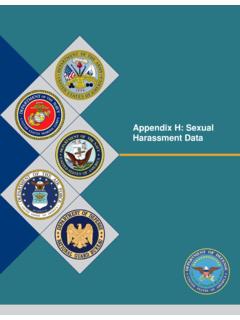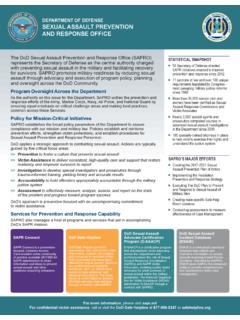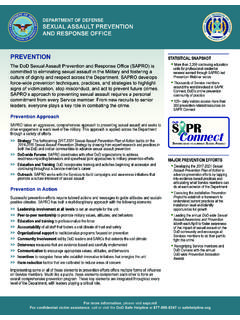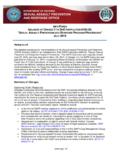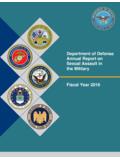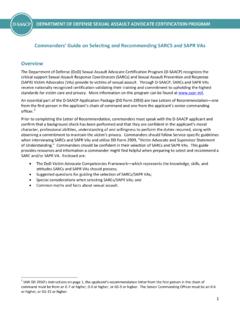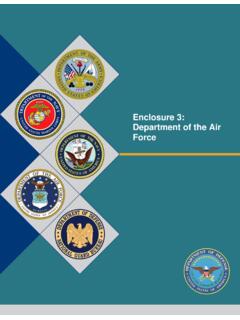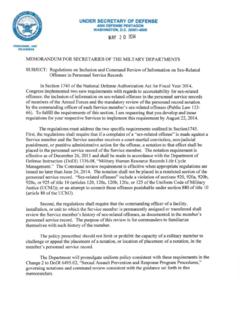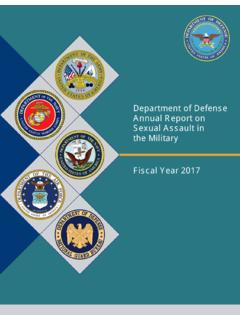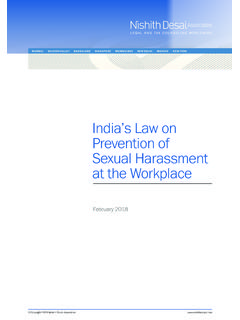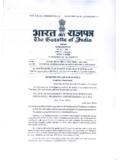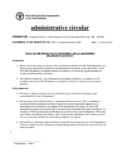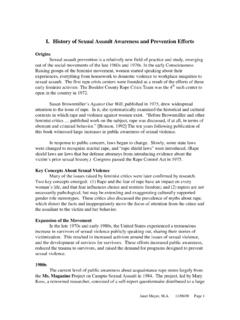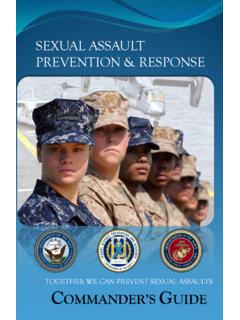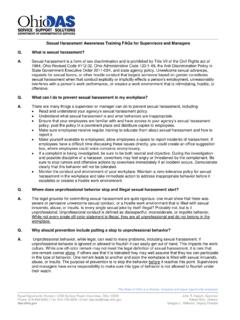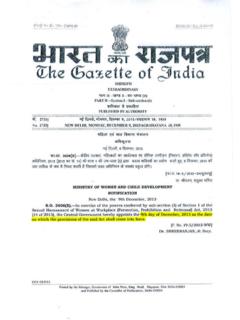Transcription of DoD Retaliation Prevention and Response Strategy …
1 DoD Retaliation Prevention and Response Strategy : Regarding sexual Assault and harassment Reports APRIL 2016 2 Table of Contents Part I: Overview .. 3 Issue Area 1 Standardizing Definitions .. 5 Issue Area 2 Closing the Gap in Knowledge .. 6 Issue Area 3 Response Process: Building Strong and Supportive Systems of Investigation and Accountability .. 8 Issue Area 4 Response Process: Providing Comprehensive Support to Reporters ..10 Issue Area 5 Creating a Culture Intolerant of Retaliation ..12 Conclusion ..13 Part II: Plan of Action .. 15 Issue Area 1 Standardizing Definitions ..15 Issue Area 2 Closing the Gap in Knowledge ..15 Issue Area 3 Response Process: Building Strong and Supportive Systems of Investigation and Accountability ..17 Issue Area 4 Response Process: Providing Comprehensive Support to Reporters ..21 Issue Area 5 Creating a Culture Intolerant of Retaliation .
2 22 APPENDIX A: Acronyms .. 25 APPENDIX B: Definitions .. 26 APPENDIX C: Retaliation Response Requirements for Key Personnel .. 29 APPENDIX D: Notional Retaliation Response Process .. 31 3 Retaliation2: For the purposes of this document, Retaliation is an umbrella term encompassing illegal, impermissible, or hostile actions taken by the chain of command or peers/coworkers as a result of making or being suspected of making a protected communication. Reporter: For the purposes of this document, a reporter is an Active Duty, Reserve, or National Guard Service member who is sexually assaulted or harassed while performing Active Service or inactive duty training and makes an allegation of Retaliation to a DoD official. The reporter may also be someone involved in a sexual assault or sexual harassment in some other way ( , military witnesses/bystanders of sexual assault/ sexual harassment and the first responder assisting the victim).
3 Part I: Overview Reports of sexual assault have dramatically increased over the past ten years through the combined, dedicated efforts of the Department of Defense (DoD), Service members, and Congress. At the same time, the occurrence of this crime as estimated by official surveys has With each passing year, greater numbers of victims who experience sexual assault are reporting their experiences to military Increased victim reporting likely reflects a growing confidence in the sexual assault Response process and is a positive step towards addressing this crime across the military. While growing numbers of victims are making the difficult choice to report sexual assault, far too often, military victims of sexual assault and complainants of sexual harassment within DoD report they were subjected to abusive behavior by their co-workers, exclusion by their peers, or disruption of their career.
4 National experts indicate this is a challenge experienced by many organizations that encourage greater employee reporting of misconduct. However, retaliatory behavior may ultimately stifle misconduct reporting. According to a 2012 report by the Ethics Resource Center: Both reporters and non-reporters take cues about the consequences for reporting from the experience of others who have reported. Once employees perceive that others are retaliated against for reporting, they will refrain from coming forward when they have concerns. Misconduct that goes unreported can continue, increasing risk, because management is never given the opportunity to address the problem. ii Retaliation2 not only harms the lives and careers of victims, bystanders/witnesses, and first responders but also undermines military readiness and weakens the culture of dignity and respect. Without question, Retaliation has no place in the Armed Forces.
5 Even though Retaliation can happen to anyone who reports, or is suspected of reporting an incident, or may report an incident, this document describes systematic efforts to eliminate this problem as it applies to military members3 who report sexual assault or sexual harassment . 1 Use of victim of sexual assault or complainant of sexual harassment refers to alleged victims and does not imply whether or not the offense was committed or whether the alleged offender committed it. In addition, when referencing retaliatory experiences, this Strategy makes no assumptions about whether the reporter actually suffered a form of Retaliation , the intent of the individuals who allegedly engaged in retaliatory behavior, or whether Retaliation occurred. 2 Retaliation for reporting a criminal offense can occur in one of several ways, including reprisal (as statutorily defined in 10 USC 1034), ostracism, or maltreatment (as defined pursuant to this Strategy ).
6 These three means do not cover all conduct that could qualify as Retaliation for example, it would not include an action taken by a peer or subordinate against an alleged victim in an effort to dissuade the alleged victim from participating in a prosecution; these categories must be expanded to include all potential retaliatory acts. 3 The Retaliation Strategy includes provisions for Active Duty, Reserve, and National Guard Service members who report a sexual assault or sexual harassment that occurred during Active Service (as 4 Survey data show that an experience of past-year sexual assault is highly correlated with an experience of past-year sexual Thus, sexual assault and sexual harassment are co-occurring problems that require continued DoD attention. This Strategy also addresses alleged Retaliation against military witnesses/bystanders4 and first responders to sexual assault and sexual harassment reports, in accordance with DoD Instruction (DoDI) To target the full spectrum of retaliatory behavior, the Secretaries of the Military Departments and the Chief of the National Guard Bureau (CNGB), in coordination with the DoD sexual Assault Prevention and Response Office (SAPRO), will develop a refined Retaliation Response process.)
7 5 This Retaliation Response process will include notifying and coordinating with the appropriate level of command and rendering comprehensive support services to Retaliation reporters by leveraging existing procedures as well as implementing new initiatives. sexual Assault Response Coordinators (SARCs) and Victim Advocates (VAs) will coordinate reports of Retaliation associated with sexual assault, and Equal Opportunity Advisors (EOAs) will manage reports of Retaliation associated with sexual harassment Under the new Retaliation Response process, the most senior SARC at an installation, or equivalent Department of Navy and National Guard personnel and structure,7 will support a Retaliation Response process for Retaliation associated with reporting sexual assault or harassment ; collaborate with other SARCs, VAs, and EOAs, as needed; serve as a liaison to communicate with the appropriate level of command and legal advisors; synchronize data collection.
8 And participate in Retaliation discussions at the Case Management Group (CMG) or Service equivalent In order to eliminate Retaliation in the military, DoD and the Services must ensure that commanders are appropriately informed, empowered, and resourced to create the professional environment Service members deserve. Correspondingly, members must be made aware of what resources and organizations are available to address retaliatory actions. The purpose of this Strategy is to outline a uniform Retaliation Prevention and Response process across the Department that can provide comprehensive support to individuals who experience Retaliation and can foster an ethical and just climate intolerant of Retaliation . The five issue areas discussed defined in Title 10, Chapter 1, section (101), and on inactive duty training) or that has a military service nexus who are served by a sexual assault Response or military equal opportunity program.
9 Reprisal against civilian employees is governed by Equal Employment Opportunity and Whistleblower Act definitions and procedures for reporting reprisal and would be handled according to those provisions. 4 Witnesses/bystanders who experience Retaliation will be offered Response services regardless of whether their account of the situation supports the victim of sexual assault/complainant of sexual harassment or the alleged perpetrator. 5 The Implementation Planning Phase will determine the role of the SARC and the Strategy processes and procedures that apply to National Guard members who report Retaliation when serving on Active Service, as defined in Title 10, Chapter 1, section (101), and on inactive duty training. 6 Army SARCs/VAs will handle Retaliation reports related to sexual assault and sexual harassment under their sexual harassment /Assault Response and Prevention (SHARP) program.
10 7 For the purpose of brevity, whenever this Strategy references a senior SARC, the meaning includes the equivalent Department of Navy and National Guard personnel, to be identified in the Implementation Planning Phase. In accordance with DoDI , the most senior SARC, known as a Lead SARC, is designated any time there is more than one SARC on a given military installation. When there is only a single SARC on an installation, that SARC will fulfill the responsibilities of the senior SARC described in this document. For expeditionary purposes, appropriately trained personnel, as identified by each Service, can perform the role of a SARC for deployed units. 8 Service equivalent meetings that address Retaliation related to sexual assault or sexual harassment should occur on a monthly basis and include, at a minimum, the following participants: SARCs for Retaliation related to sexual assault, EOAs for Retaliation related to sexual harassment , commanding officers, and agencies involved with addressing the Retaliation case.
